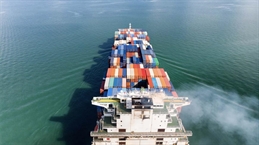
Global ocean container shipping hit a record high in carbon emissions in 2024, largely due to disruptions caused by the conflict in the Red Sea.
Data released this week by Xeneta and Marine Benchmark raises concerns about whether the International Maritime Organisation’s goal of net-zero emissions by 2050 is achievable, as emissions continue to rise.
Record-breaking emissions
The report said global container emissions increased 14% in 2024 to 240.6 million tons of carbon, comfortably surpassing the previous record of 218.5 million tons of carbon set in 2021.
"This record-breaking statistic should not be used as a stick to beat the maritime freight industry with because it is largely due to ships sailing longer distances around the Cape of Good Hope following the escalation of conflict in the Red Sea in December 2023," Xeneta said.
"A new record high is the inevitable outcome of these diversions, both in terms of the increase in transport work and the record-high demand of laden containers being moved in 2024 as shippers responded to the Red Sea crisis by frontloading imports," the ocean and air freight rate benchmarking and market analytics platform, added.
Xeneta said overall transport work (a measurement of tons of cargo moved multiplied by nautical miles sailed) increased 18% in 2024.
Emissions on the agenda
The report said the record-high emissions data is a timely reminder of the colossal task at hand following a meeting on April 7-11 of the International Maritime Organisation's (IMO) Marine Environment Protection Committee (MEPC) in London where an agreement was reached on specific reduction targets on fuel intensity in container shipping, as well as the financial penalties for non-compliance.
Xenata noted that the most significant increases are coming from the larger ships, which are also the ones experiencing the biggest increases in transport work.
Emissions from ships between 14,500 and 20,000 TEU hit 24.2 million tons in 2024. This is up 7.3 million tons, a 43% increase, compared to 2023.
Ships over 20,000 TEU also saw large increases, up 35% from 2023 to 19.6 million tons.
The two categories of ships over 14,500 TEUs accounted for 18% of total CO2 emissions from the container shipping fleet in 2024, but this statistic, Xeneta noted, takes on a different light when we consider they make up 25% of total global capacity.
It said that while ships over 14,500 TEU may have had the biggest year-on-year increases, they are perhaps not the main cause for concern. That is because ships between 8,000 and 12,000 TEU have a much higher share of total emissions.
Xeneta said a higher base in 2023 means the 51.3 million tons of CO2 emitted by this category of ship in 2024 is only up 8% year-on-year. However, these ships account for more than a fifth of total emissions despite only making up 20% of global container shipping capacity.
"The disproportionate relationship between share of shipping capacity and share of emissions is explained by bigger ships tending to be newer and therefore much more carbon efficient," it said.
It noted that an increase in transport work explains much of the emissions growth, but not all.
Xeneta said across many ship sizes the increase in emissions in 2024 is within a few percentage points of the increase in transport work. For example, it said that ships between 14,500 and 20,000 TEU saw transport work increase 43%, in line with its growth in emissions.
"This significant increase in transport work has in part been made possible by fleet growth of 26% between December 2023 and December 2024 for ships with capacity between 14,500 and 20,000 TEU," the ocean and air freight rate benchmarking and market analytics platform, added, noting that there are "some exceptions" where transport work growth and emissions growth aren’t aligned.
"On the positive side, emissions increases for smaller size ships are lower than for transport work. This is driven by improved efficiency through higher capacity utilisation and stable (if not slightly decreasing) average sailing speed," Xeneta said.
On a less positive note, it added that the biggest ships over 20,000 TEU saw emissions increase 35% in 2024, more than double the 16.6% transport work growth.
"That gap is explained by falling efficiency for these larger ships," it said, which has fallen by almost 10 percentage points for the biggest ships compared to 2023.
"The explanation is quite straightforward – total capacity offered by the largest ships in the fleet has increased, while at the same time, demand growth on key backhaul trades slowed. This meant ships were even less full on these return legs than they were previously, which eats into a ship’s annual utilisation," Xeneta said.
It noted that fronthaul volumes, measured in TEU, grew 9.5% in 2024, while demand on backhaul trades rose only 0.9%.
Meanwhile, Xeneta noted that related regulation is coming following the IMO agreement in London — a key standard in this new regulation will be the fuel intensity used by global shipping.
Starting in 2028, ships must reduce fuel intensity by a set percentage compared to the 2008 baseline. The reduction is divided into two tiers:
-
Tier 1 – Base target: A 4% reduction. Ships exceeding this threshold will pay US$380 per ton of greenhouse gas emissions above the target.
-
Tier 2 – Compliance target: A 17% reduction. Ships that fall between the base and compliance targets will pay US$100 per ton of emissions or purchase remedial units. Ships exceeding the compliance target can earn surplus units, which can be banked for two years or traded with non-compliant vessels.
"Reduction targets will increase every year, with expectations of a 65% reduction in carbon intensity by 2040. Plenty of details still need to fall into place, many of which should come in October 2025 when the agreement is expected to be finalised and adopted," Xeneta said.
"While opinions on the deal are mixed, carriers now have more certainty on the path to decarbonization."



